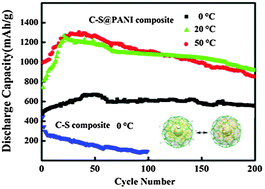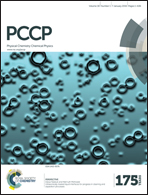C–S@PANI composite with a polymer spherical network structure for high performance lithium–sulfur batteries†
Abstract
A unique C–S@PANI composite with a conductive polymer spherical network (PSN) has been successfully designed and synthesized by a simple processing approach. The PSN framework is formed at the surface of the oxidized carbon black by conductive polymer self-assembly and grafting, followed by pouring elemental sulfur into the pores of the polymer matrix. As the cathode material for lithium–sulfur batteries, the C–S@PANI composite delivered a high specific capacity of 1453 mA h g−1 at a 0.1 C current rate and a stable cycling performance of 948 mA h g−1 after 200 cycles. The composite also demonstrated high capacities of 922 and 581 mA h g−1 at 50 °C and 0 °C, respectively, after 200 cycles. The conductive PANI coatings were connected with the C–S core–shell composites to form a three-dimensional conducting network, which improves the utilization of the active mass and dual conduction of Li+ and electrons, while at the same time encapsulating sulfur into the PANI hollow spherical network. The structure effectively inhibits the dissolution and migration of polysulfides into the electrolyte, while improving the cycling stability and the coulombic efficiency of the electrode at high current rates, especially the low temperature electrochemical properties of Li–S batteries.


 Please wait while we load your content...
Please wait while we load your content...